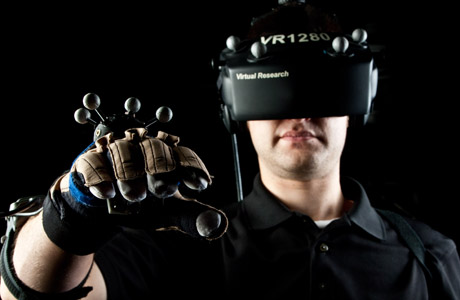
Virtual reality goggles and gloves are part of the CHIL production process that brings digital manufacturing to every step of the production process. Courtesy of Lockheed Martin.
Latest News
October 16, 2013
Manufacturing is a rapidly evolving beast, driven by a new era of digital manufacturing. 3D scanning and design, along with additive manufacturing (AM) and other high tech production processes, have the potential to significantly change the landscape of manufacturing. Final products can be built more quickly, at lower cost, and with less waste than at any other time in history.
Lockheed Martin wants to seize the digital manufacturing zeitgeist and squeeze it for all it’s worth. The company envisions a “digital tapestry” of production in which every step of the process of creating new goods is a single strand. Its tool of choice is called Model Based Engineering (MBE), an integrated toolset that updates and maintains digital data from start to finish.

“Our Digital Tapestry of production brings digital design to every stage of the production process for a fluid product development cycle,” said Dennis Little, vice president of production. “From 3D virtual pathfinding simulations to 3D printing, we are using innovative digital technology to streamline the manufacturing process for lower cycle times and reduced costs for our customers.”
Lockheed Martin’s Collaborative Human Immersive Laboratory (CHIL) is a vital part of the MBE. CHIL is a virtual reality (VR) design and simulation laboratory that can be used to optimize designs and help ensure a finished product will meet optimal specifications. The VR lab can also identify potential problems in the flow of production before they become an issue.
On the AM front, the company has stepped away from traditional manufacturing techniques for the construction of parts with complex internal geometries, or that must be built from expensive materials, such as titanium. AM not only reduces the production time of these items, but offers substantial savings as well. Like the ESA, Lockheed Martin is developing toward a future where satellites and entire aircraft wings can be produced in a single build with AM.
“Virtual pathfinding and 3D printing are just two of the innovations we are implementing … to digitalize the production process,” added Little. “From conceptualization to realization, we continue to look for new opportunities to improve the production cycle with advanced technology. In this industry, we have to continuously lean forward to new technologies to stay affordable, efficient and reliable for our customers.”
Below you’ll find a video that covers Lockheed Martin’s vision of the digital tapestry.
Source: Lockheed Martin
Subscribe to our FREE magazine, FREE email newsletters or both!
Latest News
About the Author
John NewmanJohn Newman is a Digital Engineering contributor who focuses on 3D printing. Contact him via [email protected] and read his posts on Rapid Ready Technology.
Follow DE





